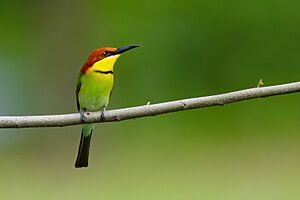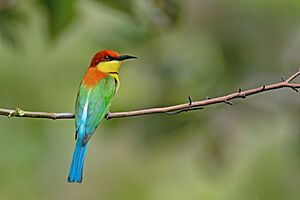Chestnut-headed bee-eater facts for kids
Quick facts for kids Chestnut-headed bee-eater |
|
|---|---|
 |
|
| West Bali National Park, Indonesia | |
 |
|
| West Bali National Park, Indonesia | |
| Conservation status | |
| Scientific classification | |
| Genus: |
Merops
|
| Species: |
leschenaulti
|
The chestnut-headed bee-eater (Merops leschenaulti) is a very colorful bird. It is also sometimes called the bay-headed bee-eater. This bird is part of the bee-eater family, known as Meropidae. You can find these birds living and raising their young in the Indian subcontinent and nearby areas. Their home stretches from India all the way to Southeast Asia.
Like other bee-eaters, this bird is slender and brightly colored. It is mostly green, with pretty blue feathers on its lower back and belly. Its face and throat are bright yellow, and it has a black stripe across its eyes. The top of its head and the back of its neck are a rich chestnut color. It has a thin, curved black beak. Both male and female birds look similar, but young birds are not as bright. These birds are about 18 to 20 centimeters long. Unlike many of its relatives, it does not have two long tail feathers in the middle.
Contents
Meet the Chestnut-Headed Bee-Eater
The chestnut-headed bee-eater was first officially described in 1817. A French bird expert named Louis Pierre Vieillot gave it its scientific name, Merops leschenaulti. The name leschenaulti honors a French naturalist and collector named Jean-Baptiste Leschenault de La Tour. He brought the bird specimen to France for Vieillot to study.
There are a few slightly different types, or subspecies, of this bird. They live in different parts of Asia. For example, one type lives in India and Sri Lanka. Another type is found in places like Sumatra, Java, and Bali. A third type lives on the Andaman Islands.
What Does It Look Like?
The chestnut-headed bee-eater is about 18 to 20 centimeters long. It weighs between 26 and 33 grams. Males and females look very much alike. The top of its head, neck, and back are a bright chestnut color. It has black stripes near its eyes.
Its wings are green, with some blue tips. The lower back and upper tail feathers are a shiny pale blue. The main tail feathers are bluish and green. The sides of its face, chin, and throat are yellow. Below the yellow, there is a wide chestnut band that connects to the chestnut on its back. Underneath this, there is a short black band, and then a less clear yellow band. The rest of its belly is green with blue tips, especially near its tail.
The bird's eyes are red, its beak is black, and its legs are dark. Young birds look similar to adults but are not as brightly colored. Their forehead and back are green, and their lower throat is yellow instead of chestnut. Their chest and belly are also paler.
Where Do They Live?
These birds prefer to live in open woodlands in warmer, sub-tropical areas. They often live near water. You will most commonly find them in highland regions.
How Do They Behave?
Chestnut-headed bee-eaters are very social birds. They like to live and eat together in groups. They also roost, or sleep, together in large groups.
Building Nests
These bee-eaters usually build their nests in small groups. They often choose sandy banks to dig their homes. They dig a long tunnel where the female lays 5 to 6 round, white eggs. Both the male and female birds work together to take care of the eggs and feed their young chicks.
What Do They Eat?
As their name suggests, bee-eaters mostly eat insects. They especially love to eat bees, wasps, and hornets! They catch these insects right out of the air. They usually sit on an open branch and then fly out quickly to grab an insect as it flies by.
Images for kids




